
When exploring legendary pirate ship designs, you'll find sleek hulls that enhance speed, like Calico Jack's The Kingston and Charles Vane's Ranger. These ships were armed with plenty of cannons for broadside attacks, seen on Blackbeard's Queen Anne's Revenge and Captain Kidd's Adventure Galley. Ships like Anne Bonny's William featured reinforced hulls and clever layouts to optimize space. The robust build of vessels such as Bartholomew Roberts' Royal Fortune guaranteed durability in battle. These ships not only captured the seas but also symbolized pirate defiance and fear. Dive deeper to uncover the riveting stories behind these infamous ships.
Blackbeard's Queen Anne's Revenge
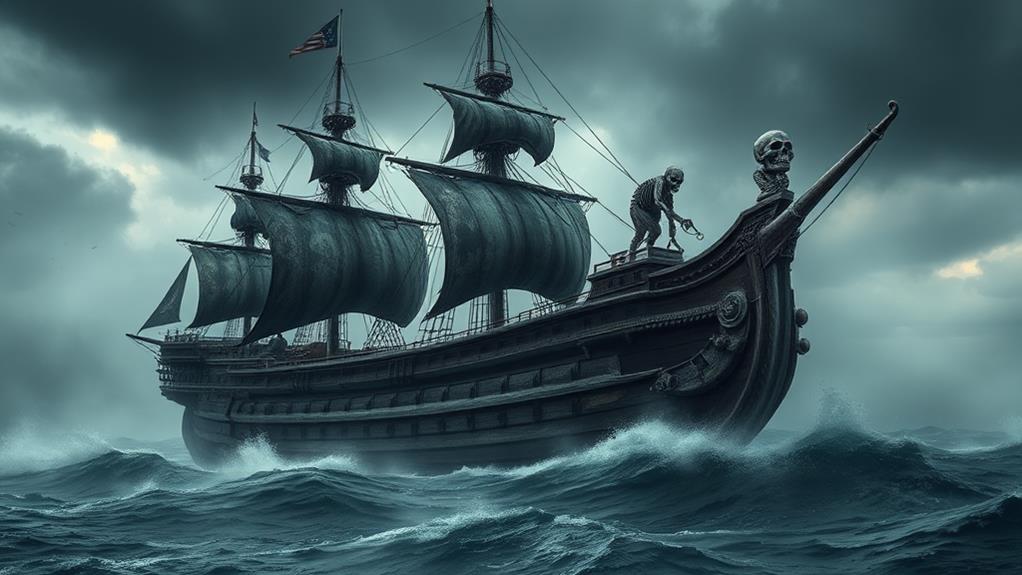
Imagine sailing on the notorious Queen Anne's Revenge, the flagship of the infamous pirate Blackbeard. This imposing vessel, originally a French slave ship named La Concorde, was captured by Blackbeard in 1717. He refitted it to suit his nefarious needs, transforming it into a fearsome pirate ship armed with 40 cannons. You'd feel the deck beneath your feet vibrate with power as the cannons roared during fierce battles.
The Queen Anne's Revenge was designed for intimidation and efficiency. Its broadside was formidable, allowing for devastating volleys against enemy ships. With a length of about 103 feet and a beam of 24.6 feet, it was large enough to carry a crew of over 300 pirates. The ship's sleek lines and reinforced hull made it fast and durable, vital for both chasing down prey and evading naval pursuers.
Below deck, you'd find ample storage for plundered goods and provisions, a tribute to its design for long voyages. The ship's layout provided swift access to weapons and supplies, vital for survival in the treacherous waters of the Caribbean. Queen Anne's Revenge wasn't just a ship; it was a floating fortress of terror.
Captain Kidd's Adventure Galley
While Blackbeard's Queen Anne's Revenge struck fear across the Caribbean, another notorious pirate ship, Captain Kidd's Adventure Galley, prowled the seas with equal menace. You'd be fascinated by the unique design of this vessel, purpose-built for both speed and firepower. The Adventure Galley was a hybrid, equipped with a combination of sails and oars, which allowed it to navigate treacherous waters and chase down prey with remarkable agility.
Originally a 287-ton ship, the Adventure Galley boasted 34 cannons, ensuring it could defend itself and overpower targets. Its three masts and square rigging were typical of the period, yet it was the addition of 23 banks of oars that made it stand out. This design allowed Captain Kidd and his crew to maneuver even when the wind was against them.
The ship's hull was constructed from durable oak, reinforced to withstand the rigors of piracy and long voyages. Below deck, you'd find ample storage for loot, provisions, and the crew's quarters. Its stern featured ornate woodwork, a legacy to its initial commission as a privateer vessel before Kidd's turn to piracy. The Adventure Galley truly embodied the ruthless efficiency of pirate ship design.
Bartholomew Roberts' Royal Fortune
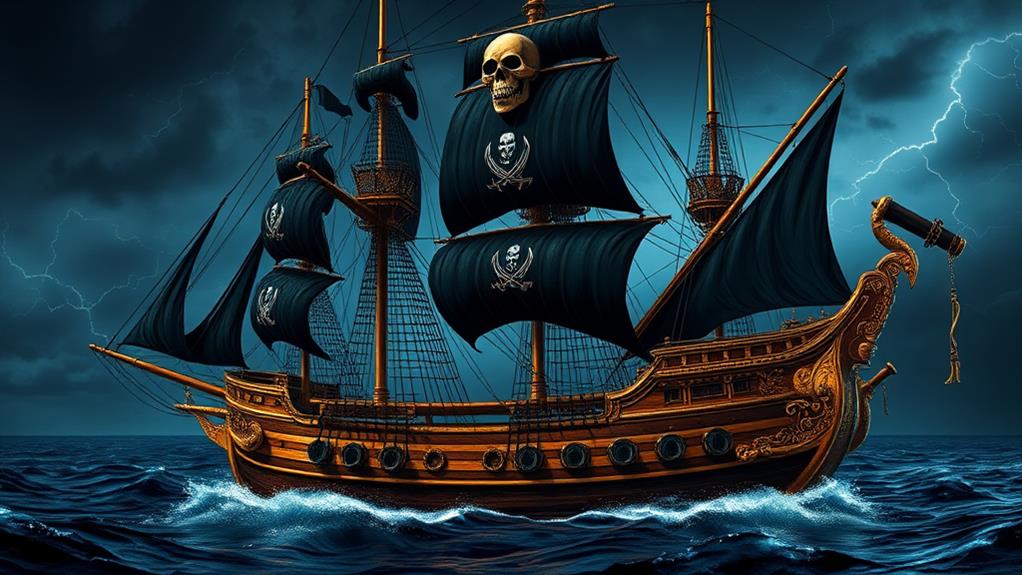
Bartholomew Roberts' Royal Fortune was the epitome of pirate grandeur and raw power on the high seas. You'd marvel at its impressive dimensions and formidable arsenal, making it one of the most feared vessels of its time. Roberts, a master pirate, didn't just build a ship; he crafted a floating fortress that could outmaneuver and outgun the best of the Royal Navy.
Imagine standing on its deck, surrounded by a well-organized crew ready to follow their captain into battle. The Royal Fortune boasted:
- Cannons:
- Equipped with 40 cannons, it could launch devastating broadsides against enemy ships.
- Speed:
- Despite its size, it was astonishingly fast, allowing Roberts to chase down or evade foes.
- Design:
- Its sleek, streamlined hull reduced drag, enhancing both speed and maneuverability.
Every detail of the Royal Fortune reflected Roberts' strategic genius. The ship's layout was designed for efficient combat, with ample space for cannons and munitions. Its robust construction guaranteed it could withstand fierce engagements and long voyages. The Royal Fortune wasn't just a pirate ship; it was a symbol of dread and dominance on the Caribbean seas.
Calico Jack's The Kingston
Calico Jack's The Kingston was a vessel that captured the essence of pirate cunning and audacity. You'd be impressed by its sleek design, which allowed for both speed and stealth. The Kingston wasn't a large ship, but its size played to its advantage, making it nimble enough to outmaneuver larger naval vessels. Its low profile reduced its visibility on the horizon, giving Calico Jack and his crew the element of surprise.
The ship's hull was reinforced with extra planks, ensuring it could withstand cannon fire and harsh sea conditions. Equipped with a formidable array of cannons on both sides, The Kingston could deliver devastating broadsides. Onboard, the deck was clear of unnecessary clutter, which meant you could move swiftly during combat.
Below deck, the space was cleverly utilized. Cargo holds stashed stolen goods, while the crew quarters were designed for quick access to weaponry. The captain's cabin was modest but functional, reflecting Calico Jack's practical nature.
The rigging and sails were meticulously maintained, ensuring maximum speed. The Kingston's agility, firepower, and rugged build made it a ship that any pirate would envy. It's no wonder it became legendary.
Anne Bonny's William
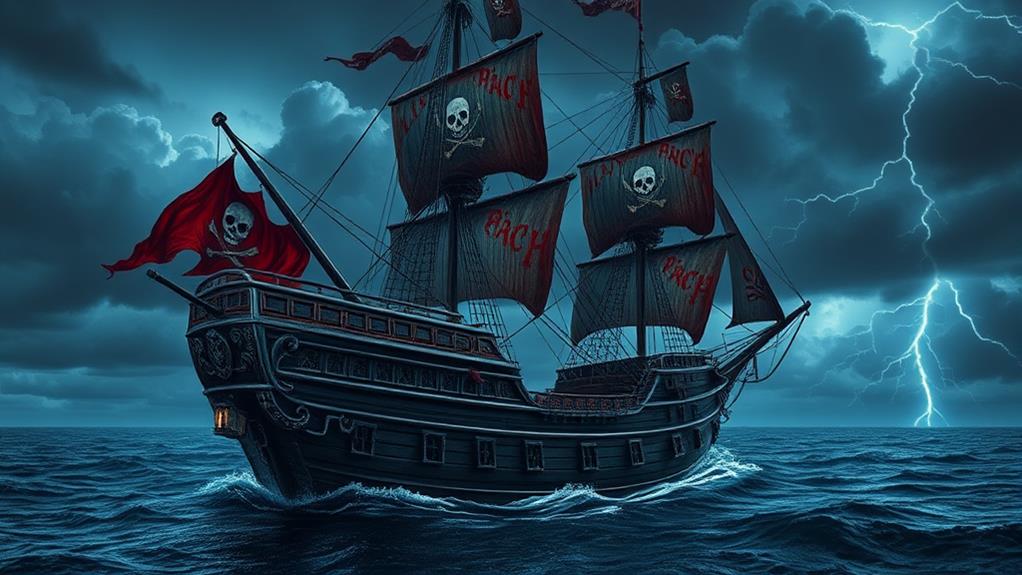
Anne Bonny's William was a ship that truly embodied the fierce and fearless spirit of its infamous captain. You can almost hear the creak of its wooden planks echoing tales of high-seas adventures and daring escapades. This vessel wasn't just any ship; it was a floating fortress designed for quick, ruthless strikes and rapid getaways.
The design of William included several standout features that made it a formidable pirate ship:
- Sleek, Streamlined Hull: This allowed the ship to cut through the water at impressive speeds, perfect for outrunning or chasing down prey.
- Heavily Armed: With cannons lining both sides, William could trigger a devastating broadside, making it a force to be reckoned with in naval battles.
- Reinforced Decking: The sturdy construction guaranteed that the ship could withstand heavy cannon fire and brutal boarding actions.
You'd find the crew always ready for action, scurrying up the rigging or manning the cannons with practiced precision. Anne Bonny's leadership instilled a sense of daring and loyalty, making William not just a ship, but a symbol of pirate defiance. With this ship, Anne Bonny carved her name into the annals of piracy.
Henry Morgan's Satisfaction
As you leave behind the tales of Anne Bonny's William, prepare to be equally captivated by the legendary ship of another notorious pirate, Henry Morgan's Satisfaction. Morgan's Satisfaction wasn't just a vessel; it was a symbol of his cunning and dominance on the high seas. This ship, originally a captured Spanish vessel, was refitted to suit Morgan's needs for speed and firepower.
You'll notice the ship's sleek design, optimized for swift maneuvers. Its shallow draft allowed it to navigate through tricky, shallow waters, giving Morgan an upper hand in coastal raids. The Satisfaction boasted impressive armament, including numerous cannons that lined its decks, offering formidable offensive capabilities.
Morgan's crew took pride in the ship's robust construction and the strategic layout of its weaponry. The deck was designed for quick reloading and firing, allowing the crew to loose relentless barrages on their enemies. Below deck, the cargo holds stored plundered treasures and essential supplies for long voyages.
Henry Morgan's Satisfaction wasn't just a pirate ship; it was a floating fortress that struck fear into the hearts of his adversaries, marking its place in the annals of pirate lore.
François L'olonnais' Tortuga Ship
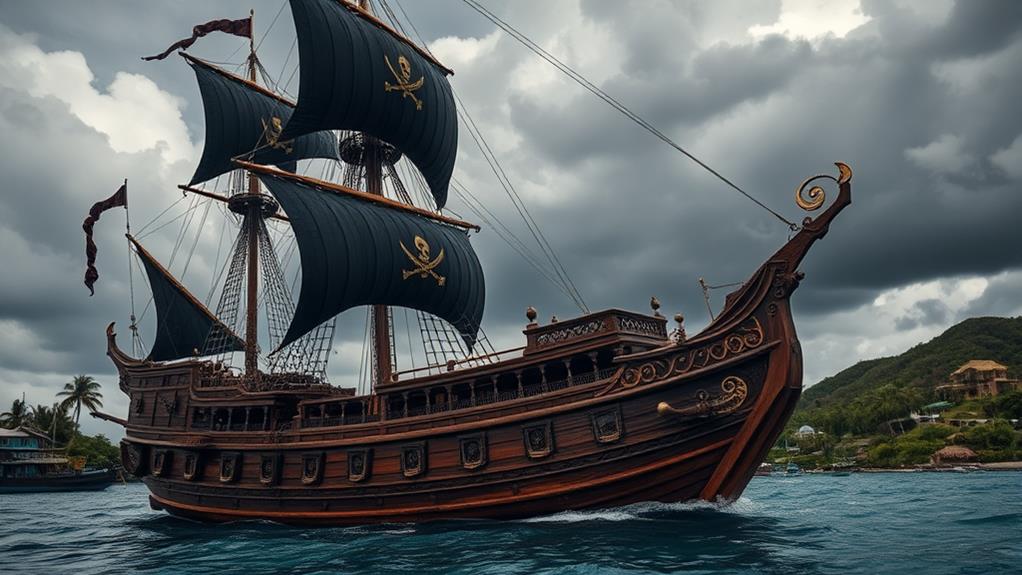
Amidst the treacherous waters of the Caribbean, François L'Olonnais' Tortuga ship emerged as a fearsome sight. Imagine sailing on this vessel, a symbol of terror among merchant ships and Spanish galleons. You'd be part of a crew notorious for its ruthlessness and cunning, skimming the waves with unmatched speed and agility.
L'Olonnais' ship was meticulously designed for piracy.
- Sleek Build: The ship boasted a streamlined hull, allowing it to outrun and outmaneuver slower, heavier vessels. This speed was vital for surprise attacks and swift getaways.
- Heavy Armament: Equipped with numerous cannons, the ship could trigger devastating broadsides. You'd find these cannons strategically placed to maximize firepower during engagements.
- Reinforced Decks: The decks were reinforced to withstand the brutal combat and harsh conditions of the high seas. This durability guaranteed the ship could endure lengthy pursuits and battles.
You'd feel the ship's power as it cut through the waves, the wind filling its sails. L'Olonnais' Tortuga ship was a masterpiece of pirate engineering, embodying the fear and respect it commanded across the Caribbean.
Samuel Bellamy's Whydah Gally
Samuel Bellamy's Whydah Gally sliced through the Atlantic waves, a monument to pirate ingenuity and ambition. You'd be amazed at how Bellamy transformed this former slave ship into a fearsome pirate vessel. Originally built in 1715, the Whydah was designed for speed and cargo capacity, perfect for transporting enslaved people. However, Bellamy saw its potential for piracy.
As you step aboard, notice the sleek hull that allowed it to outrun naval ships and merchant vessels alike. Bellamy didn't waste any time reinforcing the ship's armament. He equipped the Whydah with 28 cannons, a significant upgrade from its original six, making it one of the most heavily armed pirate ships of its time.
The ship's deck was modified for rapid boarding and swift movement during battle. Bellamy's crew could efficiently manage sails and rigging, giving them a tactical edge. Below deck, ample storage space held plundered treasure, provisions, and even prisoners.
You'd find the Whydah's design both functional and fearsome, a true legacy to Bellamy's vision. While its reign was short-lived, ending in a tragic shipwreck in 1717, the Whydah Gally remains an iconic symbol of pirate craftsmanship and daring.
Charles Vane's Ranger
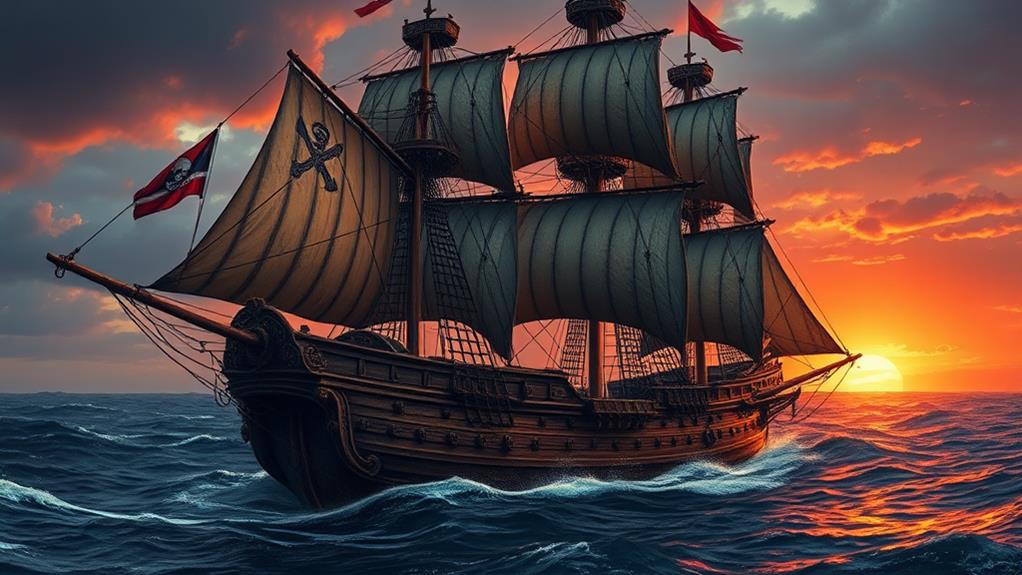
Charles Vane's Ranger epitomized the ruthless efficiency and cunning that defined its captain's notorious career. This sloop was designed for speed and agility, allowing Vane to evade capture and outmaneuver his enemies with ease. You can almost feel the tension and anticipation as you imagine the Ranger slicing through the waves, ready for the next daring raid.
To grasp the essence of the Ranger, consider these key features:
- Sleek, Narrow Hull: The Ranger had a streamlined hull that minimized water resistance, making it incredibly fast and nimble. This allowed Vane to strike quickly and disappear before his targets could mount a defense.
- Heavy Armament: Despite its relatively small size, the Ranger was heavily armed with numerous cannons and swivel guns. This firepower enabled Vane to intimidate and overpower larger vessels, ensuring successful plundering missions.
- Minimal Crew: Vane preferred a smaller, loyal crew that could operate efficiently and maintain the ship's speed. This tight-knit group of seasoned pirates knew their roles well, contributing to the Ranger's fearsome reputation.
In essence, the Ranger was a vessel that perfectly matched Charles Vane's relentless and daring approach to piracy.
At a Glance
You've now sailed through the legendary designs and architecture of history's most infamous pirate ships. Each vessel, from Blackbeard's Queen Anne's Revenge to Charles Vane's Ranger, was more than just a ship—it was a floating fortress of unimaginable power. These ships not only defined their captains' legacies but also left an indelible mark on maritime history. So, the next time you think of pirates, remember, their ships were the stuff of legends and dreams.





